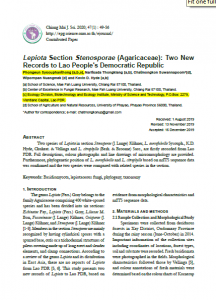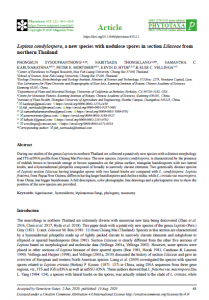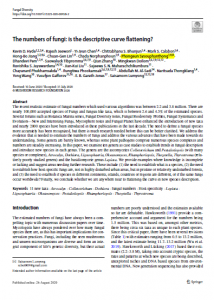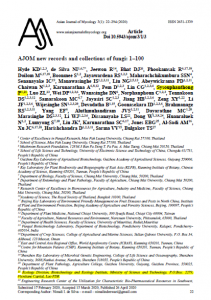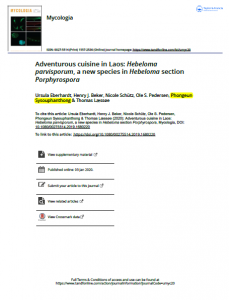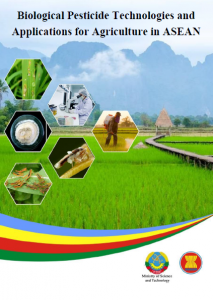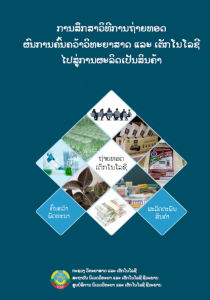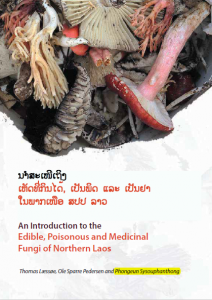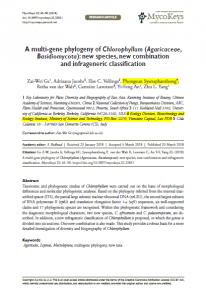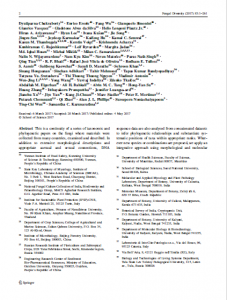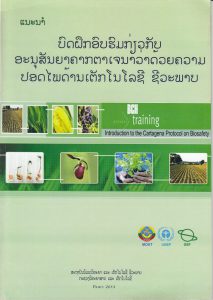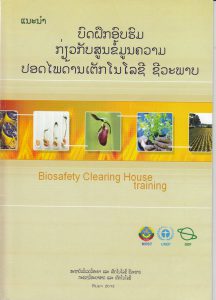Two species of Lepiota in section Stenosporae (J. Lange) Kühner, L. aureofulvella Sysouph., K.D. Hyde, Chukeat. & Vellinga and L. citrophylla (Berk. & Broome) Sacc., are firstly recorded from Lao PDR. Full descriptions, colour photographs and line drawings of micromorphology are provided. Furthermore, phylogenetic position of L. aureofulvella and L. citrophylla based on nrITS sequence data was confirmed and the two species were compared with related species in the section.
During our studies of the genus Lepiota in northern Thailand we collected a putatively new species with a distinct morphology and ITS nrDNA profile from Chiang Mai Province. The new species, Lepiota condylospora, is characterized by the presence of reddish brown to brownish orange or brown squamules on the pileus surface, triangular basidiospores with two lateral knobs, and a hymenidermal pileipellis composed of broadly to narrowly clavate elements. Two genetically distinct species of Lepiota section Lilaceae having triangular spores with two lateral knobs are compared with L. condylospora: Lepiota fraterna, from Papua New Guinea, differs in having larger basidiospores and cheilocystidia; while L. cristata var. macrospora, from China, has bigger basidiomata. A full description, color photographs, line drawings and a phylogenetic tree to show the position of the new species are provided.
This paper examined ten genera as case studies to establish trends in fungal description and introduce new species in each genus. The genera are the ascomycetes Colletotrichum and Pestalotiopsis (with many species or complexes), Atrocalyx, Dothiora, Lignosphaeria, Okeanomyces, Rhamphoriopsis, Thozetella, Thyrostroma (relatively poorly studied genera) and the basidiomycete genus Lepiota. Examples were provided where knowledge is incomplete or lacking and suggest areas needing further research. These include (1) the need to establish what is a species, (2) the need to establish how host-specific fungi are, not in highly disturbed urban areas, but in pristine or relatively undisturbed forests and (3) the need to establish if species in different continents, islands, countries or regions are different, or if the same fungi occur worldwide.
This paper is the first in the AJOM series in which we report 100 new collections of fungi which include new species, host and country records. In all, nine new species, 90 new records and one new combination are introduced. The purpose of this series is to provide an outlet for publishing collections with sequence data, so that these observations will not be wasted and mycologists can use the information to update fungal classification and better identification of species. Previously, numerous species were described from the first collection and no further data on the species were published as it was considered low impact. This series will, therefore, increase the knowledge on the host occurrence, biogeography and sequence variability in each taxon dealt with. The distribution and hosts for each listed species are added if backed up by sequence data.
Hebeloma parvisporum is described as new and placed within H. sect. Porphyrospora. This mushroom is sold as an edible in markets of Laos under the local name “wai khom.” Hebeloma sect. Porphyrospora is discussed and expanded to include the species formerly included in the genus Anamika and recently transferred to Hebeloma. Hebeloma sect. Porphyrospora currently comprises 16 species, 14 of which are known only from the western Pacific and Indian subcontinent. All species in this section share the character of having red-brown spores when fresh, atypical for other sections of Hebeloma, which causes the lamellae to be red-brown. However, this red-brown color fades when the material is dried. The close links, morphologically and molecularly, between H. parvisporum and other members of H. sect. Porphyrospora, particularly H. victoriense, are shown.
ASEAN is one of the most productive agriculture baskets in the world. An effective business model for an agriculture enterprise should always include profitability of the crop yield and the expected quality of marketable produce. This document summarizes biopesticide applications from the AMS experts who participated the ASEAN Forum on Biological Pesticide Technologies and Applications for Agriculture on 19-20 November 2019, Vientiane, Lao PDR and other open sources and publications.
ວິທີການຖ່າຍທອດເຕັກໂນໂລຊີຂອງ ສປປ ລາວ ທີ່ຖືກນຳໃຊ້ປະຈຸບັນ ແບ່ງເປັນ 2 ປະເພດຄື: ຖ່າຍທອດຄວາມຮູ້ ແລະ ນຳພາປະຕິບັດຕົວຈິງ. ອີງຕາມຂໍ້ມູນທີ່ໄດ້ຈາກການສຶກສາເຫັນວ່າ ວິທີການຖ່າຍທອດເຕັກໂນໂລຊີ ໂດຍຜ່ານການນຳພາປະຕິບັດຕົວຈິງຖືວ່າມີປະສິດທີຜົນ ຖ້າທຽບໃສ່ ວິທີການຖ່າຍທອດເຕັກໂນໂລຊີອື່ນໆ. ຜົນຂອງການສຶກສາໃນຄັ້ງນີ້ຍັງພົບອີກວ່າ ວຽກງານການຄົ້ນຄວ້າຂອງອົງກອນລັດສ່ວນໃຫຍ່ ແມ່ນການ ຄົ້ນຄວ້ານຳໃຊ້, ສຳລັບສະຖາບັນການສຶກສາ ແມ່ນໃຫ້ຄວາມສຳຄັນໃນການຄົ້ນຄວ້າພື້ນຖານ ແລະ ສ່ວນພາກເອກະຊົນ ແມ່ນອາໄສການນຳເຂົ້າ ເຕັກໂນໂລຊີຈາກຕ່າງປະເທດເປັນຕົ້ນຕໍ.
ບັນດາຂໍ້ມູນທີ່ໄດ້ບັນທຶກໃນປື້ມຫົວນີ້ ແມ່ນເປັນການແນະນໍາກ່ຽວກັບບາງຊະນິດພັນພືດຜັກປ່າ ແລະ ວິທີການນໍາໃຊ້ ທີ່ໄດ້ສຶກສາ ແລະ ສໍາຫຼວດພົບໃນ 4 ແຂວງພາກໃຕ້ (ແຂວງ ອັດຕະປີ, ສາລະວັນ, ເຊກອງ ແລະ ຈໍາປາສັກ), 5 ແຂວງພາກກາງ (ແຂວງ ສະຫວັນນະເຂດ, ຄໍາມ່ວນ, ບໍລິຄໍາໄຊ, ວຽງຈັນ ແລະ ນະຄອນຫຼວງວຽງຈັນ) ແລະ 2 ແຂວງພາກເໜືອ (ແຂວງ ໄຊຍະບູລີ ແລະ ຫຼວງພະບາງ).
Cleisostoma schoenorchaefolium is described as a new species from limestone karst in Lao PDR. A detailed description with photographs, line drawings and a conservation assessment are presented. Due to the presence of a combination of unique characters (namely, semi-terete leaves with a subulate apex, a two-chambered spur and a complex pollinarium structure), this species cannot be satisfactorily placed in any of the existing sections of the genus. Accordingly, a new section, Teretisculum, is proposed. To aid correct placement of this and other species in their respective sections, a key to infrageneric taxonomy of Cleisostoma is provided.
ປື້ມເຫຼັ້ມນີ້ ແມ່ນນໍາສະເໜີຄັ້ງທໍາອິດ ກ່ຽວກັບພາບລວມສັ້ນໆຂອງເຊື້ອຣາຂະໜາດໃຫຍ່ ຫຼື ເຫັດໃນແຂວງຊຽງຂວາງ ຢູ່ ສປປ ລາວ ເຊິ່ງມີຈຸດປະສົງ ແມ່ນເພື່ອນໍາສະເໜີເຫັດທີ່ກິນໄດ້, ເປັນພິດ ແລະ ເປັນຢາ. ເຫັດໃນພາກເໜືອຂອງລາວສ່ວນຫຼາຍ ໄດ້ສຶກສາໃນແຂວງຊຽງຂວາງ ແລະ ເປັນທີ່ຮູ້ຈັກຂອງປະຊາຊົນທ້ອງຖິ່ນ ແລະ ຄຸນປະໂຫຍດຂອງເຫັດໃນບັນດາປະເທດຢູ່ເຂດອາຊີ.
Taxonomic and phylogenetic studies of Chlorophyllum were carried out on the basis of morphological differences and molecular phylogenetic analyses. Based on the phylogeny inferred from the internal transcribed spacer (ITS), the partial large subunit nuclear ribosomal DNA (nrLSU), the second largest subunit of RNA polymerase II (rpb2) and translation elongation factor 1-α (tef1) sequences, six well-supported clades and 17 phylogenetic species are recognised. Within this phylogenetic framework and considering the diagnostic morphological characters, two new species, C. africanum and C. palaeotropicum, are described. In addition, a new infrageneric classification of Chlorophyllum is proposed, in which the genus is divided into six sections. One new combination is also made. This study provides a robust basis for a moredetailed investigation of diversity and biogeography of Chlorophyllum.
ຄູ່ມືການວິໄຈກ່ຽວກັບອະນຸກົມວິຖານເຫັດຂະໜາດໃຫຍ່ສະບັບນີ້ ໄດ້ຮຽບຮຽງຂຶ້ນເພື່ອໃຫ້ນັກຄົ້ນຄວ້າເຫັດຣາໃນລາວ ໄດ້ນໍາໃຊ້ເປັນຂໍ້ມູນໃນການວິໄຈເຫັດ, ວິທີວິໄຈ, ວິທີເກັບກໍາຂໍ້ມູນ ແລະ ວິທີເຮັດຕົວຢ່າງແຫ້ງ ແລະ ວິທີເກັບຮັກສາ ເຊິ່ງປຶ້ມຄູ່ມືສະບັບນີ້ ໄດ້ໃຊ່້ລັກສະນະເດັ່ນສະເພາະຂອງແຕ່ລະຕະກູນ ແລະ ແຕ່ລະຊະນິດ ເພື່ອຈໍາແນກເຫັດຂະໜາດໃຫຍ່ໃນຂອບເຂດປ່າສະຫງວນຫ້ວຍຍາງຈໍານວນ 77 ຊະນິດ: ສາຂາ Ascomycota ຈໍານວນ 4 ຊະນິດ ແລະ ສາຂາ Basidiomycota ຈໍານວນ 73 ຊະນິດ.
This is a continuity of a series of taxonomic and phylogenetic papers on the fungi where materials were collected from many countries, examined and described. In addition to extensive morphological descriptions and appropriate asexual and sexual connections, DNA sequence data are also analysed from concatenated datasets to infer phylogenetic relationships and substantiate systematic positions of taxa within appropriate ranks. Wherever new species or combinations are proposed, we apply an integrative approach using morphological and molecular data as well as ecological features wherever applicable.
A new species belonging to the terrestrial orchid genus Nervilia is described from Kasi District, Vientiane Province, northern Laos. Referable to the widespread and species-rich N. adolphi/punctata alliance on account of its solitary flower, slender white and violet-marked labellum and glabrous, angular leaf, N. kasiensis is morphologically most closely allied to N. muratana of southern China and northern Vietnam. As in that species, the flowering and leafing phases overlap, an unusual feature among members of the genus. The new species can be distinguished from N. muratana by its shorter inflorescence, its weakly spreading perianth with beige sepals, its narrower labellum with a central pubescent strip on the epichile, its arched column, and by its faintly tessellated leaf. A morphological description, line drawing and notes on the species’ ecology and conservation status are presented.
ບົດຝຶກອົບຮົມສະບັັບນີ້ ແມ່ນການໃຫ້ຄວາມຮູ້ພື້ນຖານເຕັກໂນໂລຊີ ຊີວະພາບ, ຄວາມປອດໄພດ້ານເຕັກໂນໂລຊີ ຊີວະພາບ, ການນໍາໃຊ້ອະນຸ ສັນຍາຄາກຕາເຈນາ ວ່າດ້ວຍຄວາມປອດໄພດ້ານເຕັກໂນໂລຊີ ຊີວະພາບ ແລະ ສົນທິສັນຍາຂອງສາກົນ, ແລະ ຄວາມສໍາຄັນຂອງອະນຸສັນຍາຄາກຕາເຈນາ ຕໍ່ກັບສິ່ງແວດລ້ອມ.
ບົດຝຶກອົບຮົມສະບັບນີ້ ແມ່ນສະເໜີເຖິງຈຸດປະສົງ ແລະ ການເຄື່ອນໄຫວ ຂອງການຝຶກອົບຮົມກ່ຽວກັບ ສູນຂໍ້ມູນຄວາມປອດໄພດ້ານເຕັກໂນໂລຊີ ຊີວະພາບ (BCH), ຄວາມຫຼາກຫຼາຍດ້ານຂໍ້ມູນກ່ຽວກັບ BCH ແລະ ຂໍ້ມູນປະເພດໃດທີ່ປະເທດພາຄືຕ້ອງການປະກາດ ແລະ ເວລາໃດ ທີ່ຂໍ້ມູນເຫຼົ່ານັ້ນ ຈະມີຢູ່ໃນ BCH.
ຄູ່ມືສະບັບນີ້ ແມ່ນນໍາໃຊ້ຮູບແບບການນໍາໃຊ້ສູນຂໍ້ມູນຄວາມປອດໄພດ້ານເຕັກໂນໂລຊີ ຊີວະພາບ ຂອງ UNEP-GEF ມາເປັນຕົ້ນແບບ, ໂດຍເນື້ອໃນໄດ້ອະທິບາຍການນໍາໃຊ້ເວັບໄຊສູນຂໍ້ມູນຄວາມປອດໄພດ້ານເຕັກໂນໂລຊີ ຊີວະພາບ.

